The John E. Marqusee Collection [151 - 200]
This page contains the fourth fifty medals listed in the John E. Marqusee Collection catalogue. The catalogue, authored by Susan Luftschein, is a wonderful resource for the American Art Medal collector and includes much beyond the simple list of medals. These pages simply attempt to provide a web-searchable repository for medals that are not all shown in the printed edition.
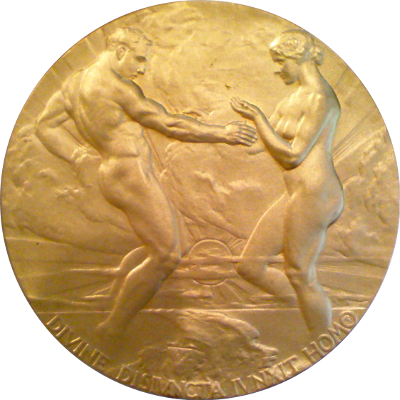
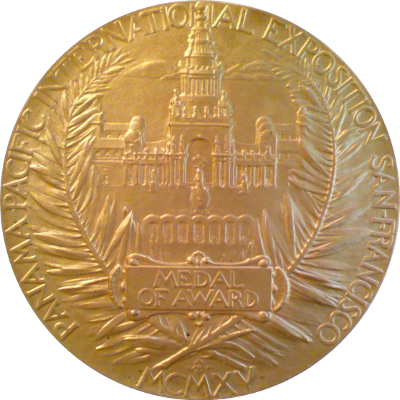
The medal's obverse bears male and female nudes symbolizing the union of the Western hemisphere by the Panama Canal; in background, sun and clouds above horizon with American isthmus. At bottom, DIVINE DISIVNCTA IVNXIT HOMO
The medal's reverse shows the Panama Pacific International Exposition's Tower of Jewels. On panel below building, MEDAL / OF AWARD; around, PANAMA PACIFIC INTERNATIONAL EXPOSITION SAN FRANCISCO - MCMXV
The medal measures 70.3mm in diameter and was struck in bronze by the United States Mint. Plain bronze, silver-plated, and gold-plated versions are known to exist.
References: Baker 114, MACo 1915-020, Marqusee 150-152

The uniface medal's obverse depicts a young woman sketching. Around, SCHOOL ART LEAG-UE OF NEW YORK CITY; on foot rest, FOR MERIT; in exergue, 19 (JF monogram) 15
The edge bears maker's mark MEDALLIC ART CO. N.Y.
The medal is also known as the John W. Alexander Medal. Alexander (1856-1915) was a painter and illustrator who died in 1915 and was commemorated by this medal.
The medal measures 68mm in diameter and was struck by the Medallic Art Company of New York. Its mintage is not reported.
References: Baxter 155, Marqusee 154
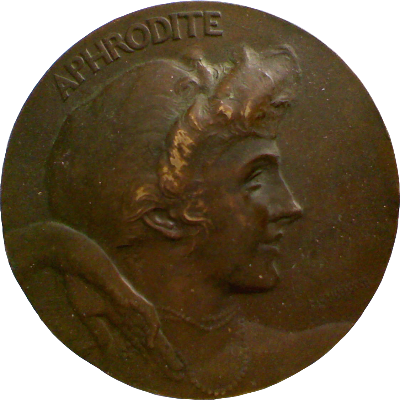
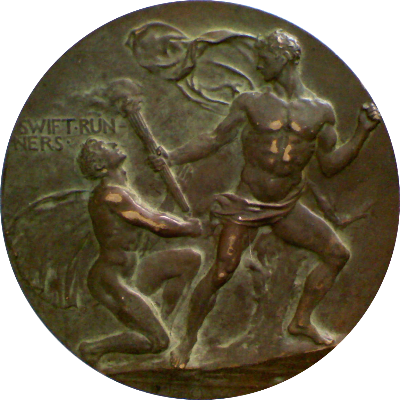
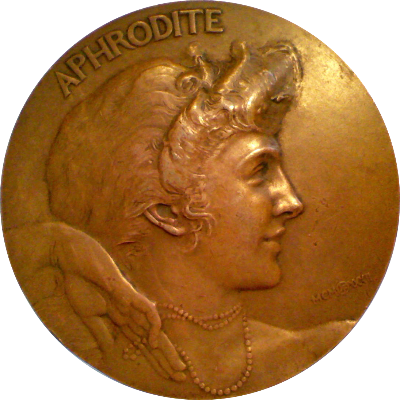
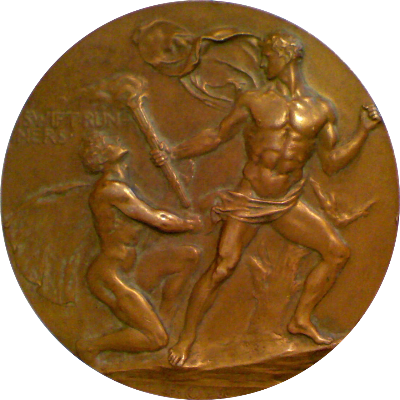
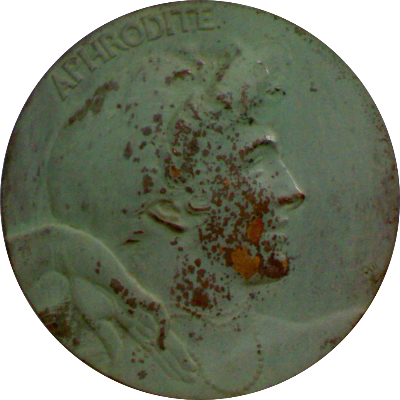
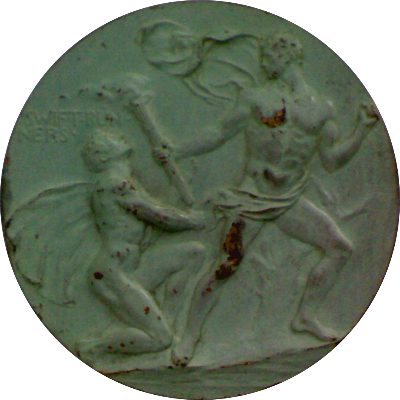

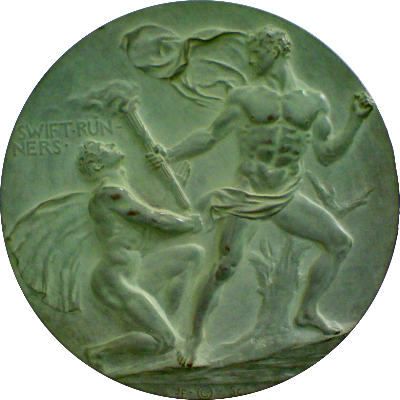
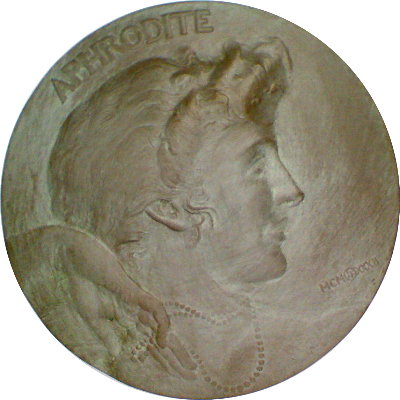
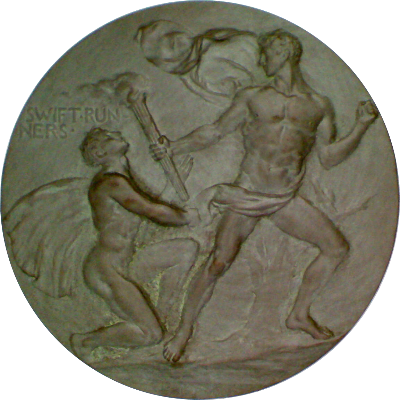
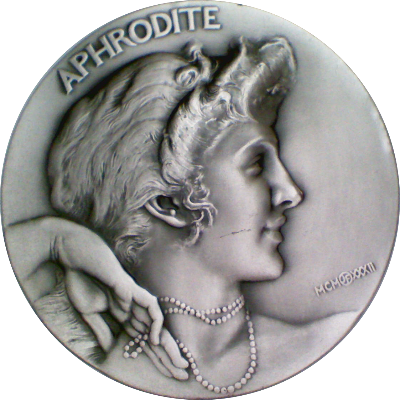

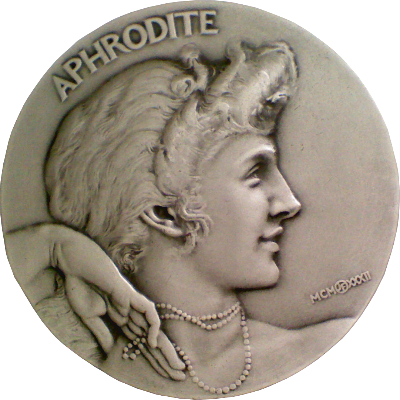
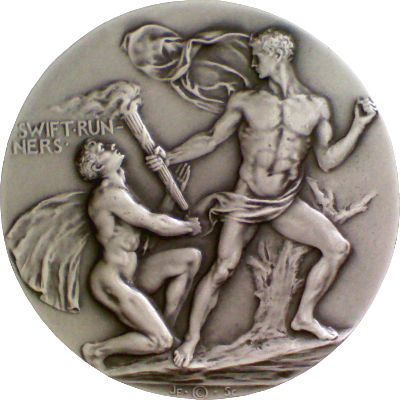
This medal was chosen as the 6th issue of the prestigious Society of Medalists series. The obverse bears an elegant beauty, one hand toying with string of pearls; above, APHRODITE; in lower right, MCM (circled JF monogram) XXXII.
The reverse bears a relay runner passing the torch to another. In upper left, SWIFT RUN- / NERS; in exergue, JF © Sc.
Flanagan's career had peaked at this point and he reused older works for his medal. The obverse is based on a 1904 marble medallion which graced August Belmont's Knickerbocker Hotel in Manhattan. The reverse was originally created for a clock that was installed in the Main Reading Room of the Library of Congress in 1902.
The medal measures 73mm in diameter and was struck by the Medallic Art Company of New York. The reported mintage is 1,494 in bronze and 125 in silver. The bronzes exist in many patina variants and even the silvers exist in two variants: one from the original silver run in the 1970's and one from a telemarketing promotion in 1993.
References: Baxter 163, MACo 1930-001-006, Marqusee 155
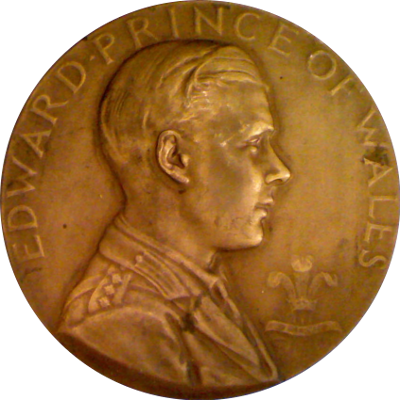
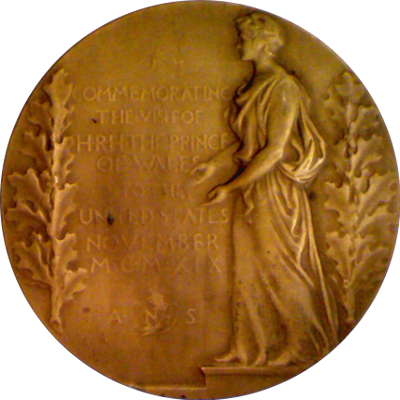
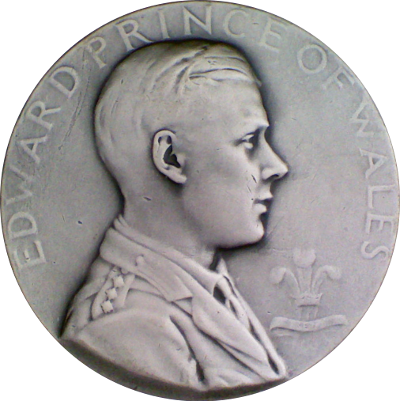
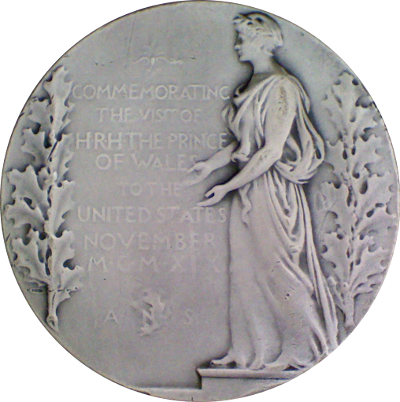
This medal was the 41st medal officially issued by the American Numismatic Society.
The obverse bears portrait of Edward, Prince of Wales, in uniform, facing right. Around, EDWARD PRINCE OF WALES; at bottom right, heraldic badge over circled (JF monogram).
The reverse displays allegorical female figure flanked by two vertical oak branches. To left of figure, COMMEMORATING / THE VISIT OF / HRH THE PRINCE / OF WALES / TO THE / UNITED STATES / NOVEMBER / MCMXIX / A N S (with oak leaves).
This was the fourth medal issued by the American Numismatic Society (ANS) in 1919, a very productive year for the Society as far as medals were concerned. J. Sanford Saltus, the great benefactor of American Medallic Art, provided not only funds covering the costs of design and die creation, but also enough money to strike one copy in gold. That copy was presented to the Prince of Wales during a ceremony on board the battleship Renown. In addition to ANS members, the privilege of subscribing to the medal was extended to the Pilgrims of the United States.
The medal measures 63.3mm in diameter and was struck by the Medallic Art Company of New York. The reported mintage is 1 piece in gold, 145 in silver, 227 in bronze, and 1 in brass (made for the British Museum).
References: Baxter 160, Johnson 35, MACo 1919-009, Marqusee 156
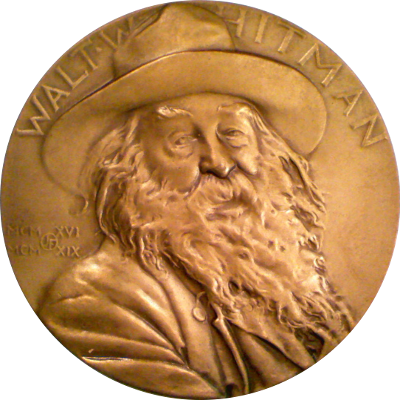
The uniface medallion's obverse bears a frontal bust of Walt Whitman wearing hat and large, unruly beard. Around top, WALT WHITMAN; over shoulder at left MCM XVI / (JF monogram) / MCM XIX
The edge is hallmarked with MEDALLIC ART CO NY BRONZE
Walter "Walt" Whitman (1819-1892) was an American poet, essayist and journalist. A humanist, he was a part of the transition between transcendentalism and realism, incorporating both views in his works. The medallion commemorates the centenary of his birth.
The medallion measures 82.2mm in diameter and was struck by the Medallic Art Company of New York. Its mintage is not reported.
References: Marqusee 157
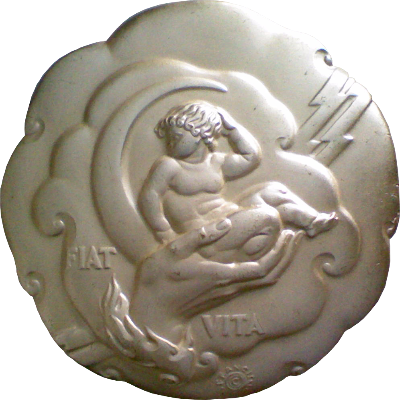
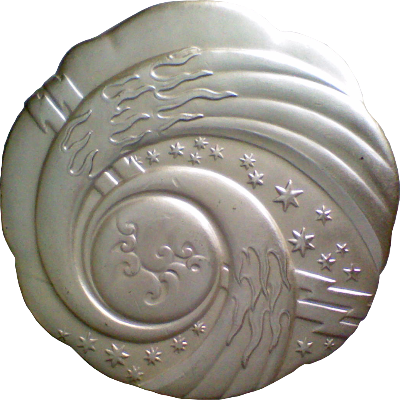
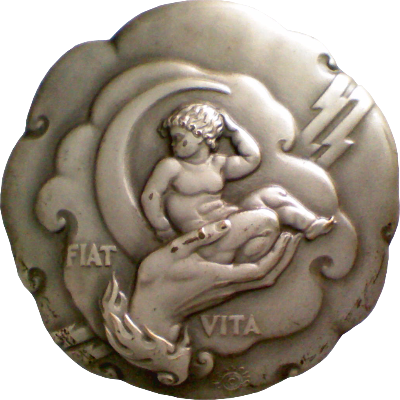
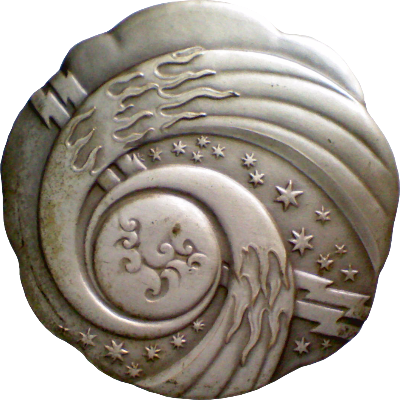
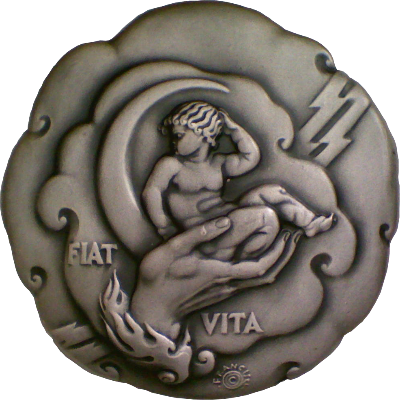
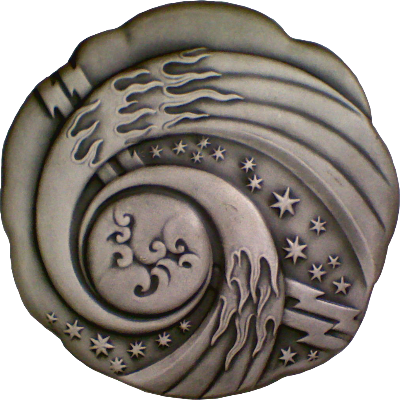
This medal was chosen as the twelfth issue of the prestigious Society of Medalists series in 1935. The obverse bears hand with flame bracelet holding infant and moon before swirling clouds and lighning. Divided by hand, FIAT - VITA; signed at bottom with large circled © and FRANCISCI ··· around.
The reverse bears streams of plasma, stars, and lightning around cloudy center, suggesting the creation of the cosmos.
De Francisci picked Creation as the theme for this medal and succeeded in creating a beautiful medal that combines both the religious and the scientific approaches in one model. The obverse shows the hand of the creator, on which rests a bold infant, secure in its place in the center of the universe. On the reverse we have a more scientific image of swirling gas clouds, hinting at cosmological processes of creation.
As de Francisci put it in his "Sculptor's Message," which focused on the scientific explanation:
"The advent of life, either in its rudimentary or complex organism, is based on the hypothesis that life could evolve and endure on all planets receiving heat and light from a central orb."
The scalloped edge incorporated the medal as a whole into the design and made it even more special.
Struck by the Medallic Art Company of New York, the medal measures 72mm in diameter and has a reported production quantity of 1,165 in silver-plated bronze and 100 in silver. This medal was re-issued in silver in 1993 as part of a promotion. The mintage of that re-issue is not known.
References: Marqusee 160
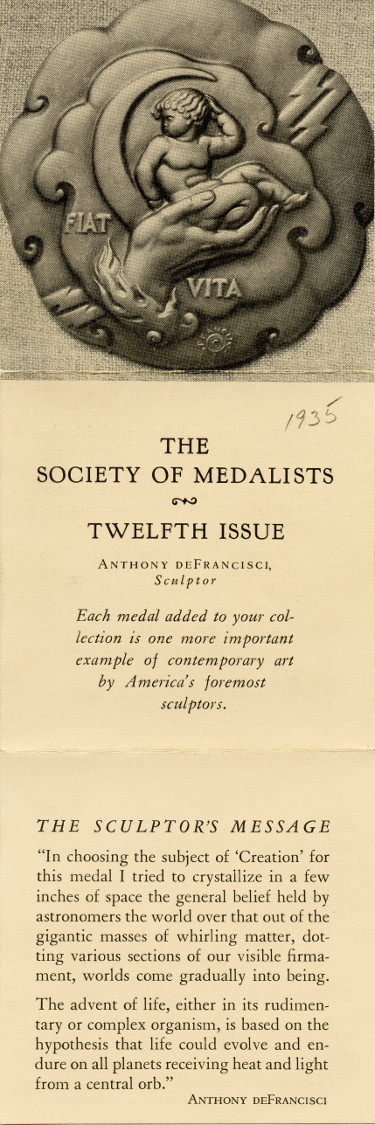
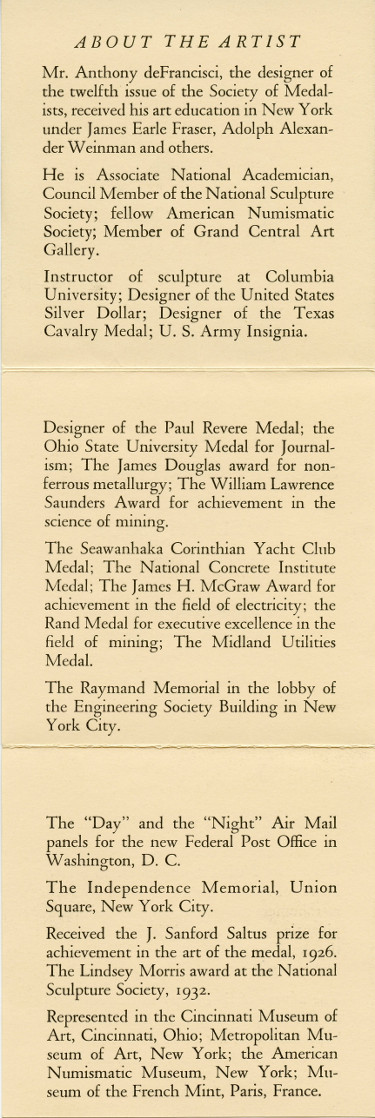

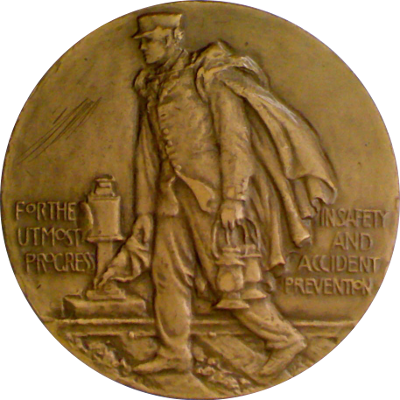
The obverse bears bust of Edward H. Harriman facing l. torch to his left. Above, (rosette) EDWARD H HARRIMAN MEMORIAL MEDAL (rosette); across bust, AWARDED - BY THE / AMERICAN - MUSEUM / OF SAFETY - TO; inscribed under bust, ATLANTIC COAST LINE RAILROAD COMPANY / GROUP A RAILROAD; signed at right, JEF monogram
The reverse bears railroad man on tracks near signal, wearing cloak and carrying signal flag and lanterns. At left, FOR THE / UTMOST / PROGRESS; at right, IN SAFETY / AND / ACCIDENT / PREVENTION
Edward Henry ("Ned") Harriman made a career of rebuilding bankrupt railroads. At age 50 he became director of the Union Pacific Railroad. A year later he was chairman of the executive board and another five years later he was president of the company. At the time of his death in 1909 he controlled the Union Pacific, the Southern Pacific, the Saint Joseph and Grand Island, the Illinois Central, the Central of Georgia, the Pacific Mail Steamship Company, and the Wells Fargo Express Company.
With the explosive growth in railroads around the beginning of the 20th century, accidents became an ever larger concern to the industry and to the public. In 1913 Edward Harriman's widow, who had inherited her husband's entire estate, sponsored this medal to encourage the young industry to pay more attention to the safety of its employees.
The American Museum of Safety presented medals in gold, silver, and bronze to railroads in three groups of line-haul carriers and a fourth group of switching and terminal companies for attaining the best employee safety records during the preceding year.
This medal measures 70mm in diameter. Early versions were struck by Tiffany and Co. in bronze, silver, and gold; later versions by the Medallic Art Company. The mintages are not reported.
References: Baxter 233, Freundlich 34, Marqusee 161, Storer 6626
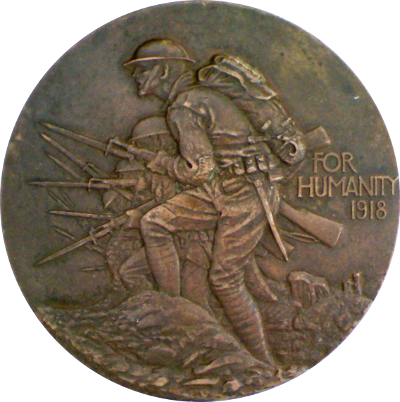
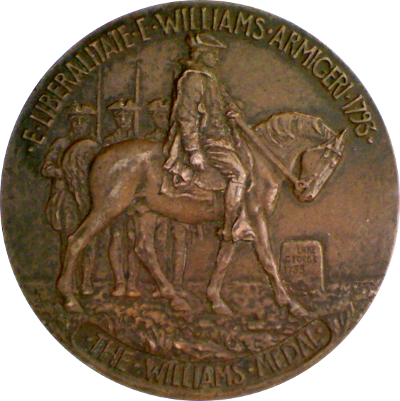
The obverse bears line of steel-helmeted doughboys, rifles in hand, with bayonets fixed, about to go over the top. To right, FOR / HUMANITY / 1918.
The reverse bears imaginary portrait of Col. Ephraim Williams, founder of Williams College, on horseback, in the uniform of a Continental Army officer. Around top, E LIBERALITATE E WILLIAMS ARMIGERI 1793; at bottom, THE WILLIAMS MEDAL;
Edge engraved to GOODRICH C. SCHAUFFLER PRIV.
The official description for the medal's reverse is actually a bit incorrect. The medal depicts Williams at Lake George in 1755, so he is in the uniform of a French and Indian War officer, not a Continental officer.
This medal measures 73mm in diameter and was struck in bronze. The college awarded a total of 1726 pieces to Williams men who served in World War I.
References: Baxter 320, Marqusee 165
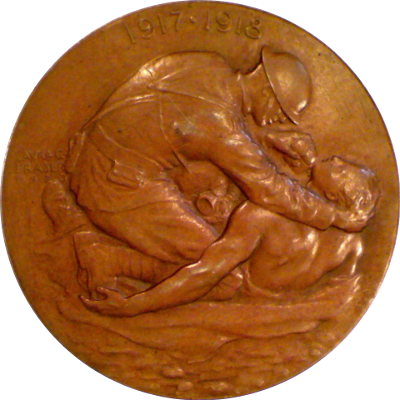
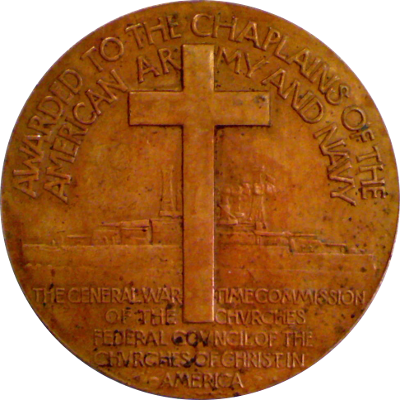
The obverse bears a U.S. Army Chaplain, wearing steel helmet, kneeling facing right, assisting wounded soldier in drinking from water bottle. At upper edge, 1917 - 1918; signed at left, LAURA G / FRASER / 1920.
The reverse bears cross over U.S. Navy dreadnought, South Carolina class 1908. Around upper edge, AWARDED TO THE CHAPLAINS OF THE / AMERICAN AR-MY and NAVY; across lower half, THE GENERAL WAR-TIME COMMISSION / OF THE - CHURCHES / FEDERAL COUNCIL OF THE / CHURCHES OF CHRIST IN / AMERICA.
The medal was awarded by the General Committee of Army and Navy Chaplains to the Protestant Chaplains who served with the Army and Navy of the United States during World War I.
The medal measures 70mm in diameter and was struck in bronze by the Gorham Company.
References: Baxter 326, Marqusee 166
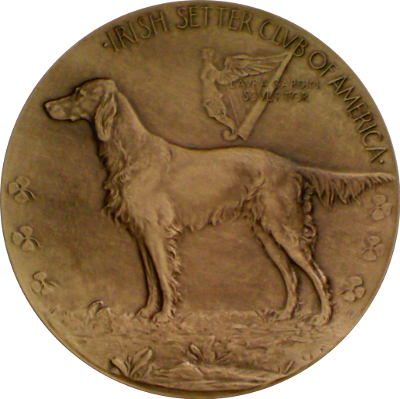
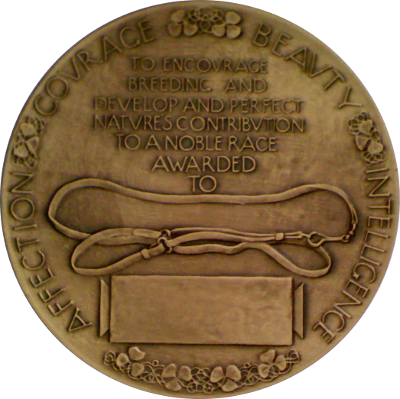
The obverse bears a champion setter at attention under an Irish harp. Three clover leaves on each side. Around, IRISH SETTER CLUB OF AMERICA; over harp, signed LAURA GARDIN / SCULPTOR.
The reverse bears leash over dedication panel. Around, AFFECTION (*) COVRAGE (*) BEAVTY (*) INTELLIGENCE; in center, TO ENCOVRAGE / BREEDING AND / DEVELOP AND PERFECT / NATVRE'S CONTRIBVTION / TO A NOBLE RACE / AWARDED / TO.
This medal measures 76.3mm (3in) in diameter and was struck in bronze by the Medallic Art Company of New York.
References: Baxter 357, Marqusee 170
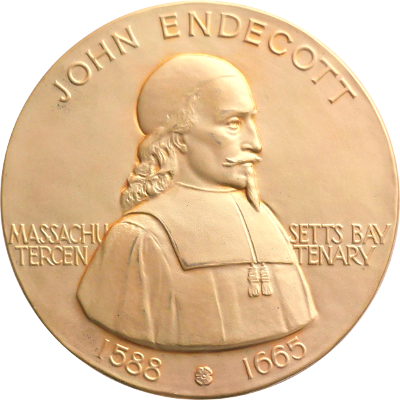
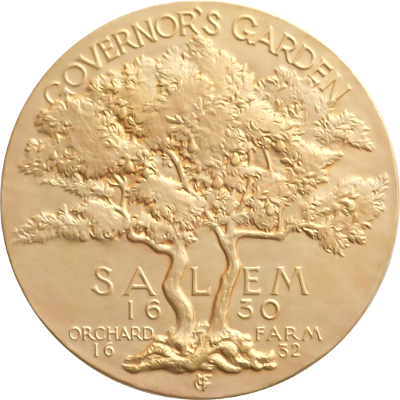
The obverse bears a large bust of John Endecott, facing right. Above, JOHN ENDECOTT; across, MASSACHU - SETTS BAY / TERCEN - TENARY; below 1588 (flower) 1665. The reverse bears the image of the famous Endecott pear tree. Above, GOVERNOR'S GARDEN; accross, SA - L - EM / 16 - 30 / ORCHARD - FARM / 16 - 32; signed LGF below.
John Endecott was born in 1588 in Chagford, England. He was an English colonial magistrate, soldier and the first governor of the Massachusetts Bay Colony. During all of his years in the colony but one, he held some form of civil, judicial, or military high office. He died in Boston on March 15, 1665. The tree on the medal's reverse refers to the Endecott Pear Tree in Danvers, Massachusetts. John Endecott planted the tree in 1633 and it is alive and bears fruit to this day.
Approximately 200 of these large, 100mm diameter bronze medals were struck in 1930 by the Medallic Art Company of New York.
References: Marqusee 171
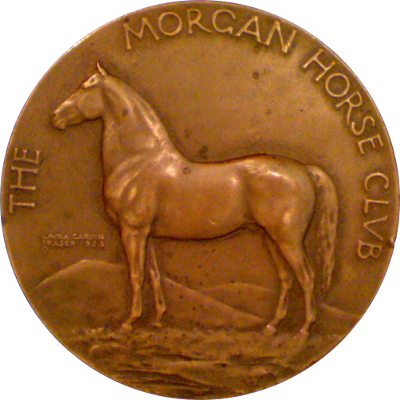
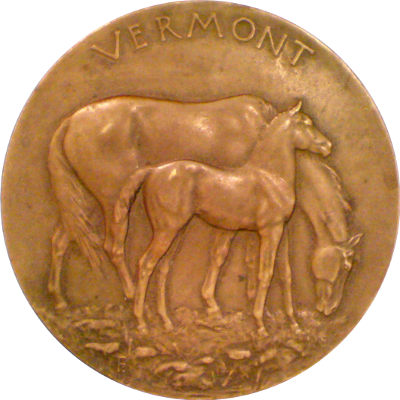
The obverse bears a Morgan horse in profile, facing left. Around, THE MORGAN HORSE CLVB; signed at left next to horse's chest, LAVRA GARDIN / FRASER 1923 / ©
The reverse bears mare with young colt facing right. Above, VERMONT; signed at bottom left, (LGF monogram) / 1923 / ©
The edge is marked MEDALLIC ART CO NY
The Morgan horse is one of the earliest horse breeds developed in the United States. Its foundation sire was named Figure, later Justin Morgan after his best-known owner. Morgans were used as coach horses, harness racing, general riding animals, and as cavalry horses during the Civil War.
This medal measures 75mm in diameter and was struck in bronze by the Medallic Art Company of New York.
References: Baxter 358, Marqusee 173
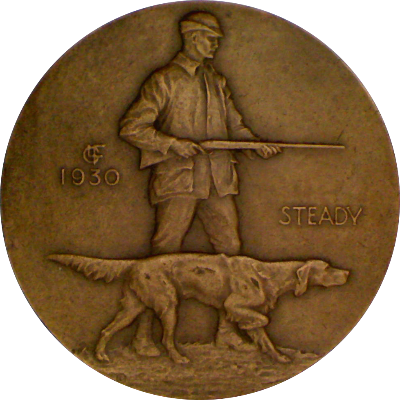
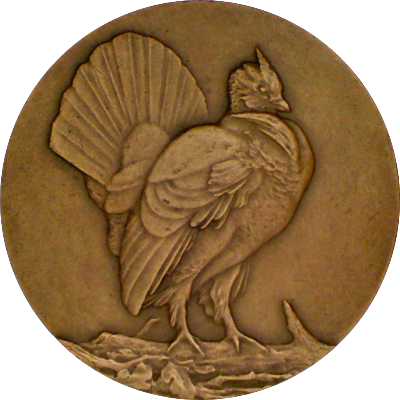


This medal was chosen as the first issue of the prestigious Society of Medalists series. The obverse bears a hunter with rifle at ready, dog at point. To right, STEADY; to left, LGF 1930; at lower left ©. The reverse bears a ruffed grouse in display plumage on fallen log.
For this medal, Laura Gardin Fraser went back to some of her early medallic subjects that she was well known for: small animals. Rather than just creating an animal-themed medal, she put them in the human context of the hunt. It was a smart and popular choice, exactly what the new Society of Medalists needed. She wrote in the brochure that accompanied the medal:
"There are many persons who desire to collect medals but are unable to do so because the medal is used in most instances as a specific award. The scope of subject matter which bears no relation to a particular person or occasion embraces many forms of expression and the sculptor has a large field of choice. In this case, I felt that a sporting subject would be a departure from what one has been accustomed to seeing in medallic art. Therefore, I chose the hunter with his dog because it presented the opportunity of telling a story embodying a human and animal element.
The Medallic Art Company of New York struck a reported 3,235 pieces in bronze. A reported 125 silver medals were struck from the same dies in the 1970s."
References: Marqusee 174
All that being said, this medal in bronze typically trades on eBay between $90 and $130. Silver variants come up very rarely and can fetch several hundred dollars, typically in the $300 to $600 range.

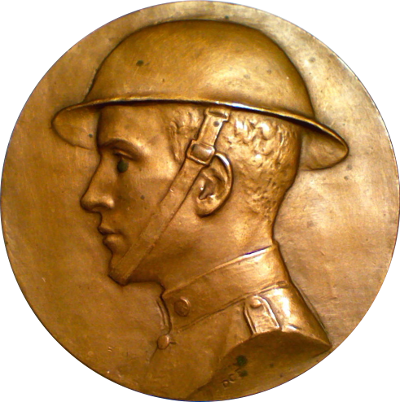
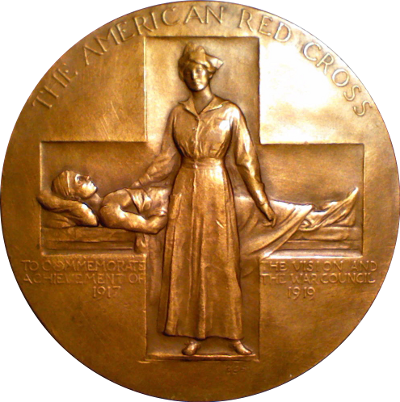
This medal was the 42nd issue of the American Numismatic Society.
The obverse bears bust-length profile image of soldier wearing helmet. Signed below bust, DCF.
The reverse bears image of nurse attending injured soldier depicted within cross. Above, THE AMERICAN RED CROSS; to left and right of vertical bar of cross, TO COMMEMORATE - THE VISION AND / ACHIEVEMENT OF - THE WAR COUNCIL / 1917 - 1919; signed below cross, WHL / DCF.
The medal is numbered and contains the maker's mark MEDALLIC ART CO. NY.
This medal was co-issued by the American Red Cross and the American Numismatic Society in 1920. Daniel Chester French designed it and the Medallic Art Company executed it. The initials of Reverend William H. Low in the medal's reverse were included due to his suggestion that the the nurse stand in front of the bed.
The medal was awarded to twelve New York businessmen who volunteered for the War Council of the American Red Cross. As the Red Cross Bulletin Vol. IV No. 51 (December 13, 1920) states:
"The General Board also presented to the four members of the Wat Council who were present the special Daniel Chester French medal, authorized at its last meeting in recognition of their war service. These were Eli Wadsworth, Cornelius N. Bliss Jr., George E. Scott and Charles D. Norton. The eight other members of the War Council who will receive their medal are Henry P. Davison, chairman; William Howard Taft, George B. Case, Jesse H. Jones, Edward N. Hurley, John D. Ryan, Grayson M., P. Murphy, and Harvey D. Gibson."
The medal measures 70mm (2.75in) and was struck by the Medallic Art Company of New York. The reported mintage is 12 pieces in gold, 4 in silver and 205 in bronze.
References: Baxter 237, Marqusee 176
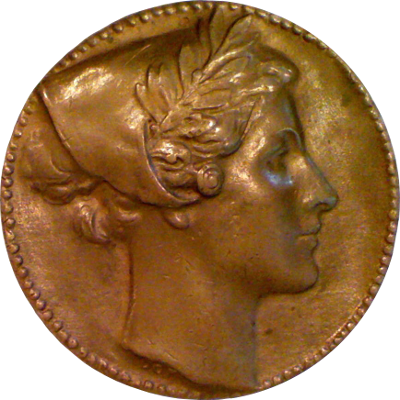

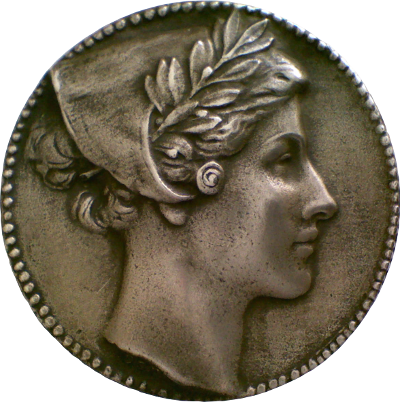
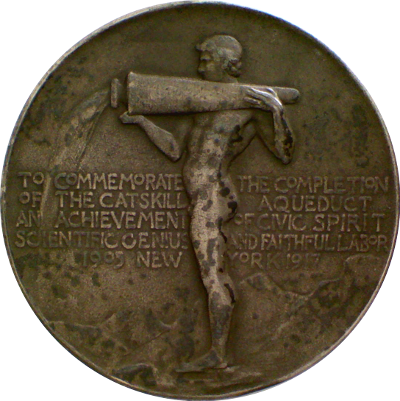
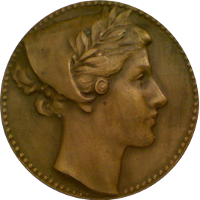
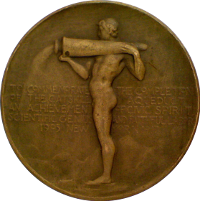
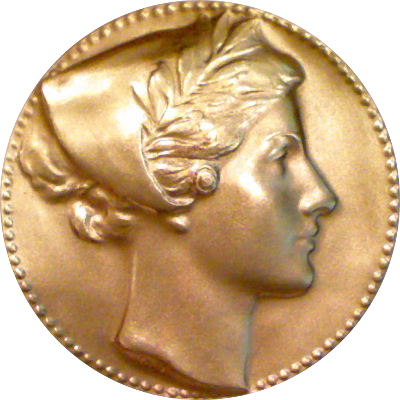
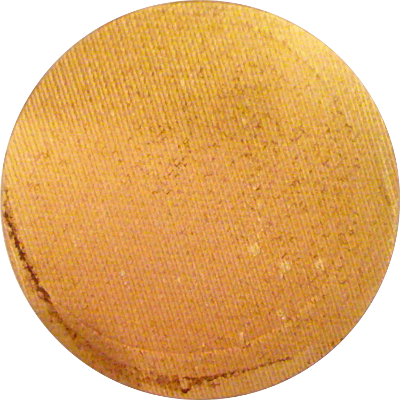
This is the 35th official issue of the American Numismatic Society.
The obverse bears a female head (alternatively representing Greater New York or Columbia) crowned with laurel in high relief, facing right.
The reverse depicts a full figure of nude male facing left, standing erect, pouring water from classic vase resting on his shoulder. On Left and right, TO COMMEMORATE - THE COMPLETION / OF THE CATSKILL - AQUEDUCT / AN ACHIEVEMENT - OF CIVIC SPIRIT / SCIENTIFIC GENIUS - AND FAITHFUL LABOR / 1905 NEW - YORK 1917
This medal was authorized by the Medal subcommittee of the Mayor's Catskill Aqueduct Celebration Committee and issued by the American Numismatic Society (ANS).
Daniel Chester French won this commission through his acquaintance with Robert de Forest, with whom he served on the board of trustees of the Metropolitan Museum of Art and who also was the president of the Mayor's Catskill Aqueduct Celebration Committee. The committee was convened to organize the celebrations in honor of the completion of the massive Catskill Aqueduct project. Construction had started twelve years earlier in 1905. By 1917 a 163-mile long system of tunnels and pipes had been completed to transport water from the Catskill Mountains to New York City.
Although the medal is commonly credited to Daniel Chester French, the obverse was actually designed by both French and Augustus Lukeman.
In 1933, Clyde Curlee Trees, the President of Medallic Art Company chose French's beautiful female head as the symbol of his company and obviously gained permission to use the design in many different ways. The head became not only the company logo but also appeared on bronze replica medals that were struck in an unknown quantity. As late as 1979 the Medallic Art Company issued gold-plated struck bronzes in the small diameter.
The original medals measured 76mm in diameter and were cast by the Medallic Art Company in a quantity of 57 bronze and 12 silver pieces. Later, an unknown number of the smaller 38mm diameter brones were struck by the Medallic Art Company.
References: Baxter 245, Marqusee 177








This is the 35th official issue of the American Numismatic Society.
The obverse bears a female head (alternatively representing Greater New York or Columbia) crowned with laurel in high relief, facing right.
The reverse depicts a full figure of nude male facing left, standing erect, pouring water from classic vase resting on his shoulder. On Left and right, TO COMMEMORATE - THE COMPLETION / OF THE CATSKILL - AQUEDUCT / AN ACHIEVEMENT - OF CIVIC SPIRIT / SCIENTIFIC GENIUS - AND FAITHFUL LABOR / 1905 NEW - YORK 1917
This medal was authorized by the Medal subcommittee of the Mayor's Catskill Aqueduct Celebration Committee and issued by the American Numismatic Society (ANS).
Daniel Chester French won this commission through his acquaintance with Robert de Forest, with whom he served on the board of trustees of the Metropolitan Museum of Art and who also was the president of the Mayor's Catskill Aqueduct Celebration Committee. The committee was convened to organize the celebrations in honor of the completion of the massive Catskill Aqueduct project. Construction had started twelve years earlier in 1905. By 1917 a 163-mile long system of tunnels and pipes had been completed to transport water from the Catskill Mountains to New York City.
Although the medal is commonly credited to Daniel Chester French, the obverse was actually designed by both French and Augustus Lukeman.
In 1933, Clyde Curlee Trees, the President of Medallic Art Company chose French's beautiful female head as the symbol of his company and obviously gained permission to use the design in many different ways. The head became not only the company logo but also appeared on bronze replica medals that were struck in an unknown quantity. As late as 1979 the Medallic Art Company issued gold-plated struck bronzes in the small diameter.
The original medals measured 76mm in diameter and were cast by the Medallic Art Company in a quantity of 57 bronze and 12 silver pieces. Later, an unknown number of the smaller 38mm diameter brones were struck by the Medallic Art Company.
References: Baxter 245, Marqusee 177
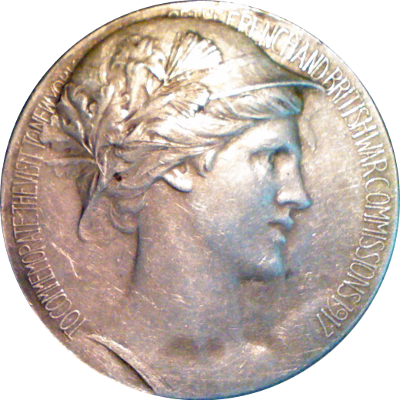
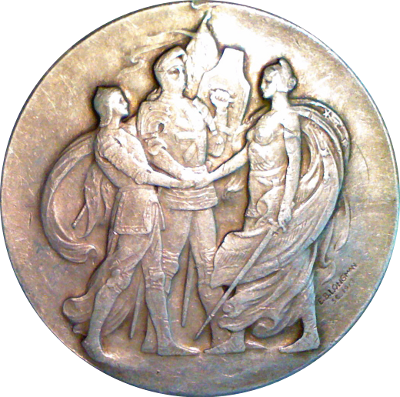
This is the 34th official issue of the American Numismatic Society.
The obverse bears softly modeled and beautiful head of Victory (r.), wearing helmet decorated with the lilies of France, the oak leaves of Britain and the pine of the United States. Around, TO COMMEMORATE THE VISIT TO NEW YORK - OF THE FRENCH AND BRITISH WAR COMMISSIONS 1917; signed on collar, D C FRENCH.
The reverse bears allegorical group of three figures. On the right, standing figure of female Liberty holding sword, greeting figures of Joan of Arc and medieval knight representing France and England. Signed at lower right, E.B.LONGMAN / SC. 1917.
The medal is numbered and edge-marked MEDALLIC ART CO. N Y.
The United States officially entered World War I in 1917 and quickly tried to coordinate the war effort with the the European allies. The French and British delegations were first to arrive and were given a spectacular reception. New York mayor John Purroy Mitchel had put together a Committee of Reception that was in charge of organizing the event. As part of the activities, the committee and the American Numismatic Association (ANS) teamed up to issue this commemorative medal. They engaged Daniel Chester French and Evelyn Longman to design the two sides of the medal. Evelyn Longman was one of French's students and the first woman sculptor to be elected a full member of the National Academy of Design in 1919.
Barbara Baxter considers this medal one of French's "most outstanding pieces," the other one being his American Red Cross medal.
The medal measures 63.4mm (2.5in) and was struck in bronze, silver and gold by the Medallic Art Company of New York. The mintage is 5 in gold, 109 in silver and 171 in bronze.
References: Baxter 317, Marqusee 180
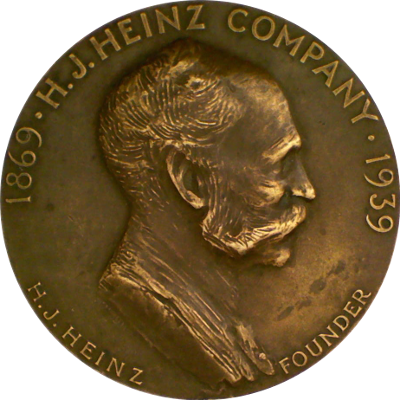
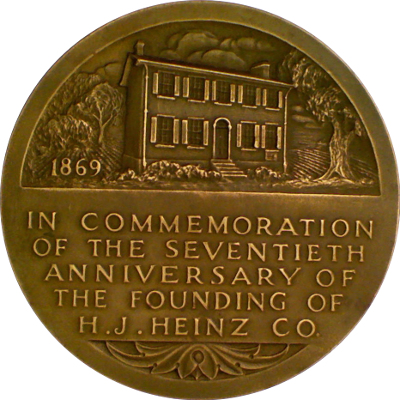
The obverse bears bust of H. J. Heinz facing right. Around upper edge, 1869 - H.J.HEINZ COMPANY - 1939; around lower edge, to left and right, H.J. HEINZ - FOUNDER
The reverse bears founder's house and garden, founding year 1869 next to house; Across, IN COMMEMORATION / OF THE SEVENTIETH / ANNIVERSARY OF / THE FOUNDING OF / H.J. HEINZ CO.
The edge is marked MEDALLIC ART CO. N.Y. BRONZE
The medal's obverse was designed by Emil Fuchs in 1922 for the H.J. Heinz Company medal which was issued to those of its 6,500 employees who had served twelve years. The Fuchs design was reused for a number of company commemorative issues, including this one. The reverse was designed and sculpted by Rene P. Chambellan.
The medal measures 76mm (3in) in diameter and was struck in bronze by the Medallic Art Company of New York.
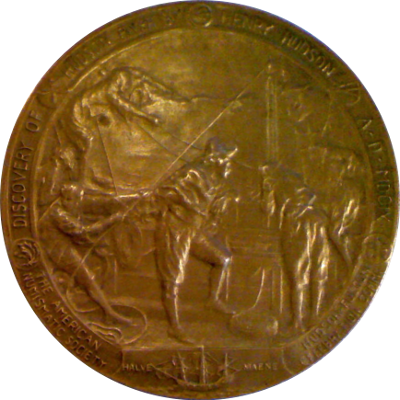
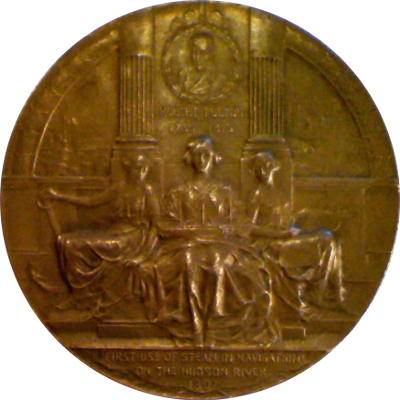
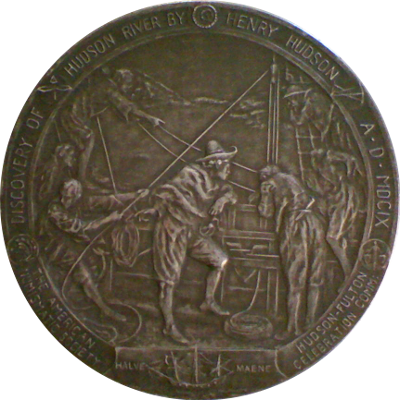
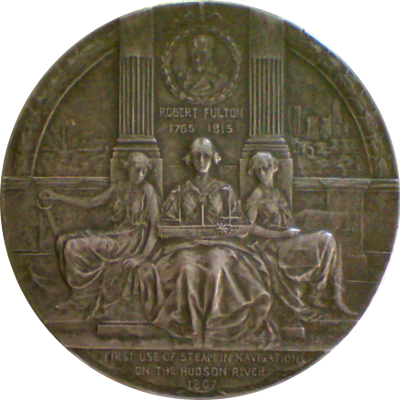
This medal was the 23rd official issue of the American Numismatic Society.
The obverse bears Henry Hudson and sailors on the Halve Maen during the hoisting of some freight onto the ship. Around top, DISCOVERY OF HUDSON RIVER BY HENRY HUDSON A D MDCIX; at lower left, THE AMERICAN NUMISMATIC SOCIETY; at lower right, HUDSON-FULTON CELEBRATION COMM.; in exergue, HALVE MAEN; signed in lower right corner, E FUCHS
The reverse bears three seated female figures representing Steam Navigation, History, and Commerce; above, portrait of Robert Fulton. In background, views of New York in 1807 and 1909. Below portrait, ROBERT FULTON / 1765 1815; in exergue, FIRST USE OF STEAM NAVIGATION / ON THE HUDSON RIVER / 1807; signed in lower right corner, E FUCHS
This medal, in one of its many variants, is probably one of the most common ANS medals being traded. There are 15 known variants ranging from 1¼in silver-plated to 3in gold and 4in silver. Even the large gold variant had 11 pieces produced! This is probably the most successful ANS medal ever.
The offical medal measures 76mm in diameter and was struck by Tiffany & Company of New York as well as Whitehead and Hoag of Newark. The reported mintage for the official ANS issue is 100 pieces in silver but there is a wide range of variants that are listed separately.
References: Baxter 99, Marqusee 186, 187




This medal was the 23rd official issue of the American Numismatic Society.
The obverse bears Henry Hudson and sailors on the Halve Maen during the hoisting of some freight onto the ship. Around top, DISCOVERY OF HUDSON RIVER BY HENRY HUDSON A D MDCIX; at lower left, THE AMERICAN NUMISMATIC SOCIETY; at lower right, HUDSON-FULTON CELEBRATION COMM.; in exergue, HALVE MAEN; signed in lower right corner, E FUCHS
The reverse bears three seated female figures representing Steam Navigation, History, and Commerce; above, portrait of Robert Fulton. In background, views of New York in 1807 and 1909. Below portrait, ROBERT FULTON / 1765 1815; in exergue, FIRST USE OF STEAM NAVIGATION / ON THE HUDSON RIVER / 1807; signed in lower right corner, E FUCHS
This medal, in one of its many variants, is probably one of the most common ANS medals being traded. There are 15 known variants ranging from 1¼in silver-plated to 3in gold and 4in silver. Even the large gold variant had 11 pieces produced! This is probably the most successful ANS medal ever.
The offical medal measures 76mm in diameter and was struck by Tiffany & Company of New York as well as Whitehead and Hoag of Newark. The reported mintage for the official ANS issue is 100 pieces in silver but there is a wide range of variants that are listed separately.
References: Baxter 99, Marqusee 186, 187

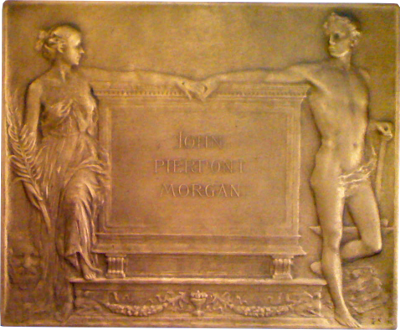
This is the 30th official issue of the American Numismatic Society.
The obverse bears facade of building with four columns; in center, female figure representing Art descending steps, holding statuette in right and laurel wreath in left hand. On sides, representations of Painting and Sculpture. Above, CHARACTER RELIGION FRIENDSHIP; immediately below, MDC / CCXXX / VII and MCM / XIII; at lower left, (ANS seal); signed at lower right, E. FUCHS
The reverse bears tablet inscribed JOHN / PIERPONT / MORGAN flanked by two draped figures, female holding palm branch representing Fame at left, male with sledge hammer and anvil representing Industry at right.
The rectangular medal measures 90mm x 74mm and was struck by Whitehead and Hoag of Newark, New Jersey. The mintage is 1 piece in gold, 100 pieces in silver and an 200 pieces in bronze.
References: Baxter 292, Marqusee 188
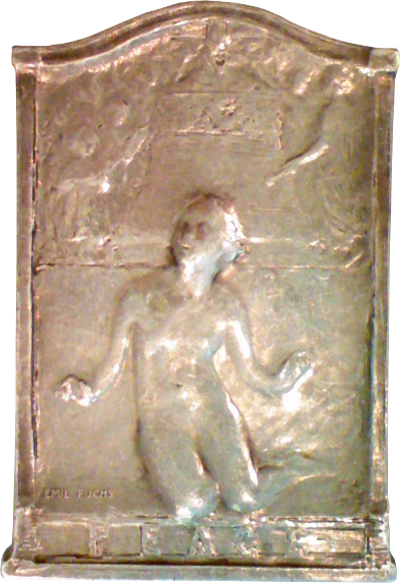
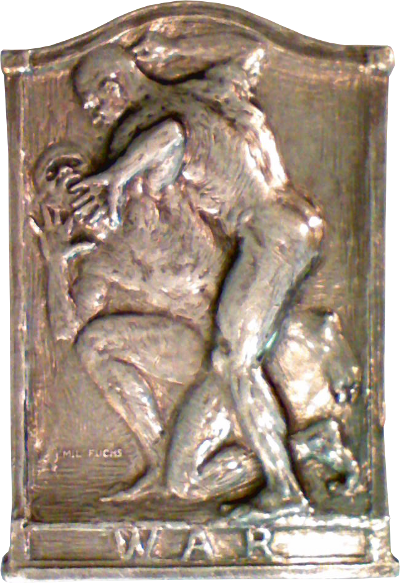
The obverse bears kneeling nude female figure gazing upwards in supplication. At bottom, PEACE; signed at bottom left, EMIL FUCHS
The reverse depicts a fight between two muscular nude male figures, one almost cowering, the other looming above him in almost theatrical pose. WAR inscribed in the exergue; signed at bottom left, EMIL FUCHS
The bottom edge is marked with "PAT PENDING" CARTIER NEW YORK - PARIS - LONDON; numbered 24 on left edge.
This medal was issued by Cartier and struck to commemorate the Treaty of Versailles marking the end of World War I. Miller also notes that
"Fuchs had previously submitted a design to the American Numismatic Society for its Peace medal. The Society eventually awarded the commission to Chester Beach. Although there is no documentation to support this theory, it is possible that this medal reflects that rejected design.
The medal measures 48mm x 70mm and was struck in bronze and silver by Cartier.
References: Miller 44, Baxter 322, Marqusee 190
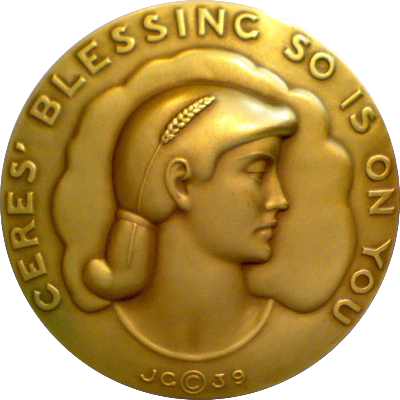
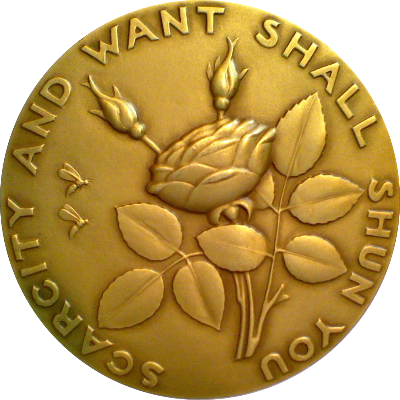
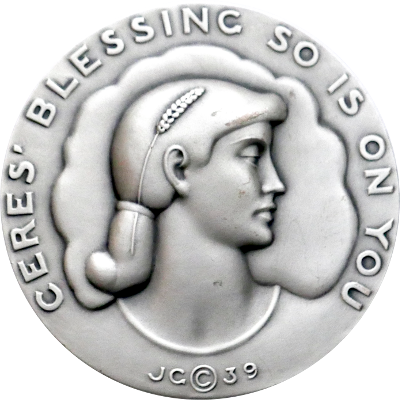

This medal was chosen as the 20th issue of the prestigious Society of Medalists series in 1939. The obverse bears the goddess Ceres in profile right. Around, CERES BLESSING SO IS ON YOU. Below, JG © 39. The reverse bears the blooming rose with two bees. Around, SCARCITY AND WANT SHALL SHUN YOU.
The reported production quantity of this medal is 937.
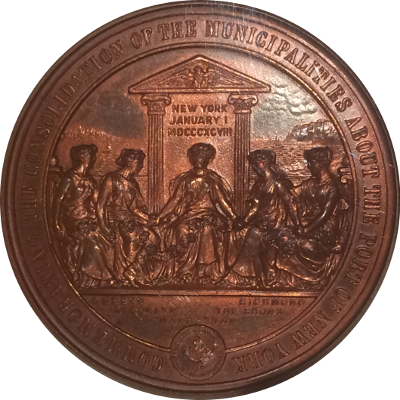
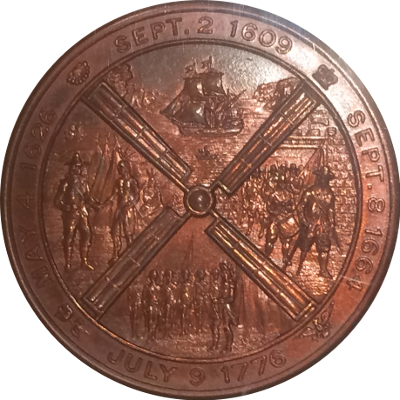
This is the 13th medal issued by the American Numismatic Society.
The obverse bears five seated female figures representing the five burroughs, the names of each burrough beneath them. Behind figures, within ornamented pediment supported by two columns, inscription, NEW YORK / JANUARY 1 / MDCCCXCVIII; view of New York harbor in background; seal of Society at bottom. Around, COMMEMORATING THE CONSOLIDATION OF THE MUNICIPALITIES ABOUT THE PORT OF NEW YORK
The reverse bears four vignettes divided by the four arms of a Dutch windmill. Starting on left, in counter-clockwise direction, the vignettes depict Peter Minuit purchasing Manhattan Island from the Indians, Henry Hudson's Halve Maene, the Dutch evacuating Fort Amsterdam, a Contiental Army officer reading the Declaration of Independence. Around, (tulip) MAY 4 1626 (scallop shell) SEPT. 2 1609 (crown) SEPT. 8 1664 / JULY 9 1776 (eagle)
The medal measures 64mm in diameter. Designed by Edward Hall and modeled and struck by Tiffany & Company, the reported mintage for this medal is 1 piece in gold, and unknown numbers in silver and bronze. I own a piece that—at least according to PCGS—seems to be struck in copper and is not documented in the great Miller book on the ANS medal series.
References: Marqusee 197
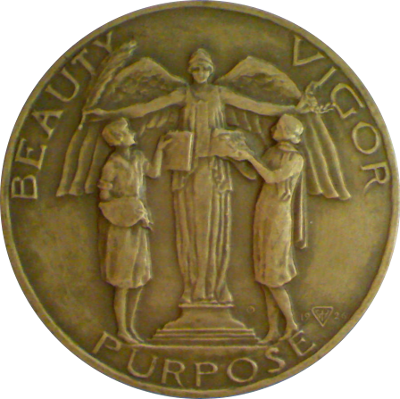
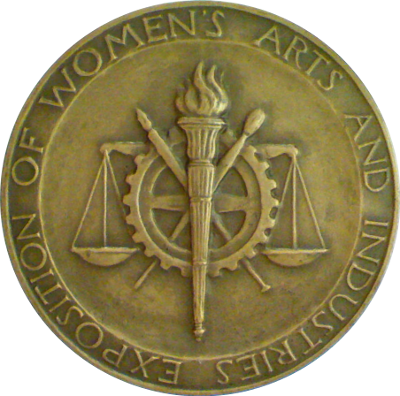
The obverse bears winged female with spread arms on pedestal; two women to left and right displaying object to her. Around, BEAUTY - VIGOR - PURPOSE; signed in lower right quadrant, © 19 (GH monogram in triangle) 26
The reverse bears brning torch over gear, scales, and crossed pen and brush. Around, EXPOSITION OF WOMEN'S ARTS AND INDUSTRIES
The edge is marked MEDALLIC ART CO.N.Y.
The Exposition of Women's Arts and Industries seems to have been an event that started in the late 1910s or early 1920s (the seventh exposition took place in 1928) to provide female artists and designers a venue to display their creations without being crowded out by their male counterparts.
The medal measures 57mm in diameter and was struck by the Medallic Art Company of New York. The mintage is not reported.
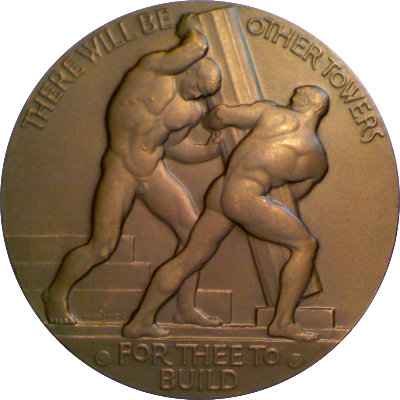

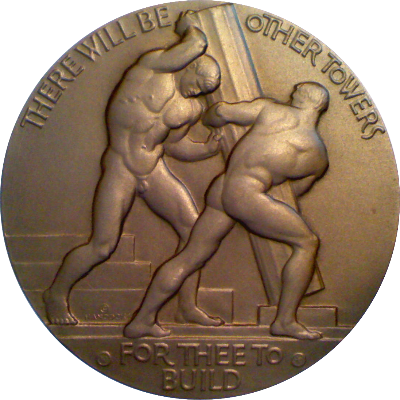
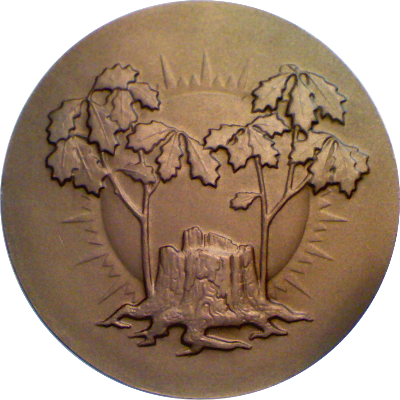
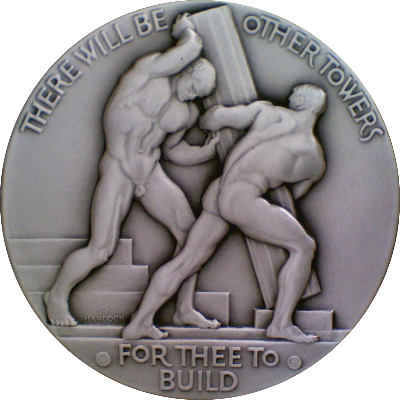
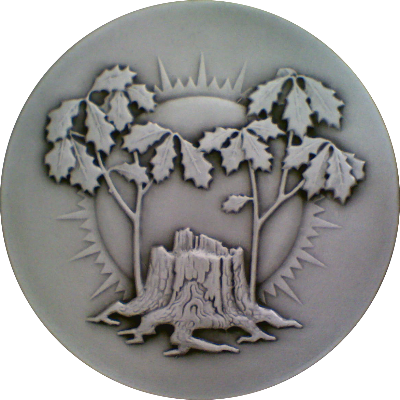
This medal was chosen as the 22nd issue of the prestigious Society of Medalists series in 1940. The obverse bears muscular men raising a fluted pillar. Above, THERE WILL BE OTHER TOWERS; in exergue, (circled 19) FOR THEE TO / BUILD (circled 40); above ground line at left, © HANCOCK
The reverse bears a shattered oak stump with two hardy well-leafed shoots; sun behind.
Hancock designed this optimistic medal when the second World War was still young. His message was that renewal and creation will surely follow death and destruction. As he wrote in his message "From the Artist":
"As the earth renews itself after the ruin of storm, so man must rebuild his towers -material and spiritual- after the wreck of war."
This medal measures 73mm in diameter and was struck by the Medallic Art Company of New York. Its reported production quantity is 894 in bronze and 100 in silver.